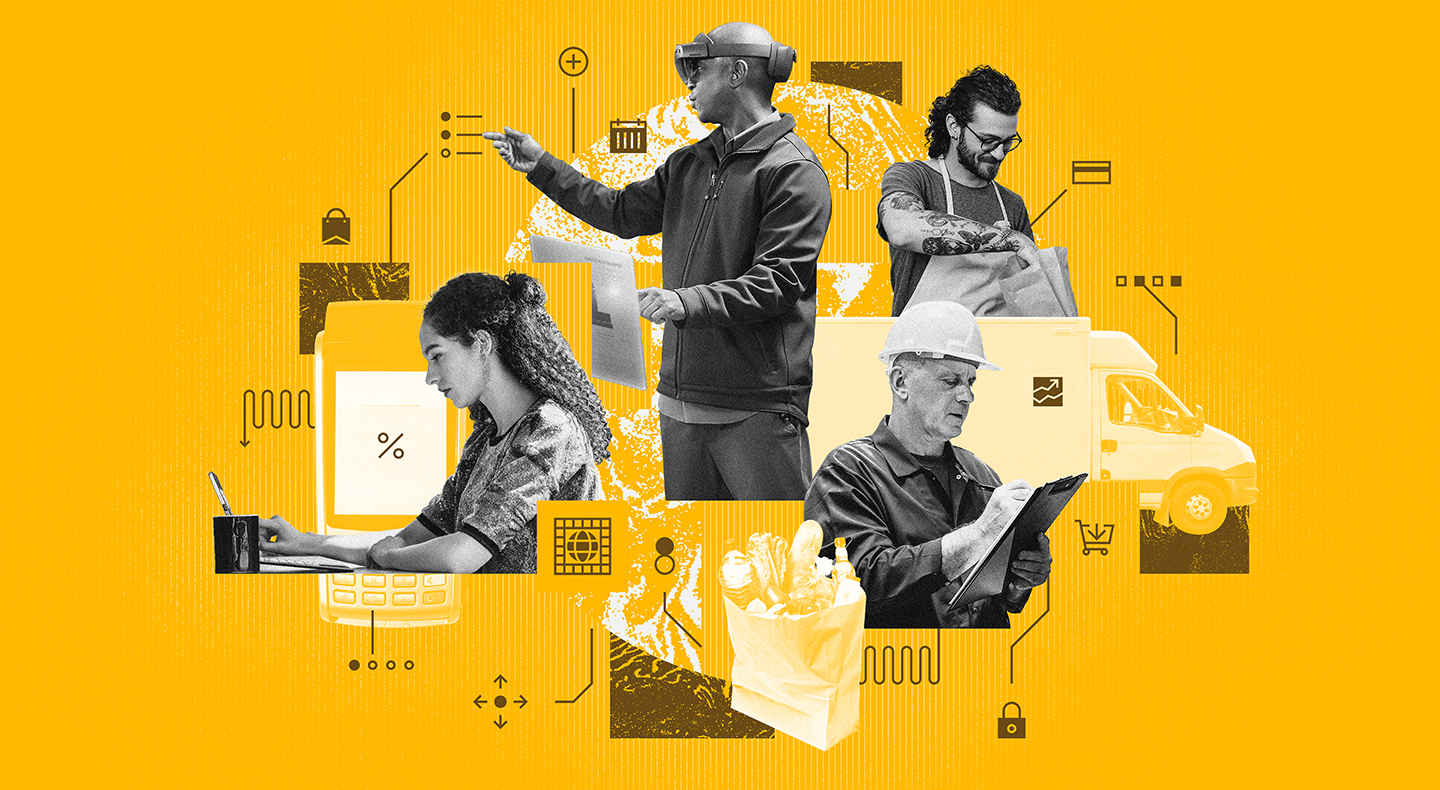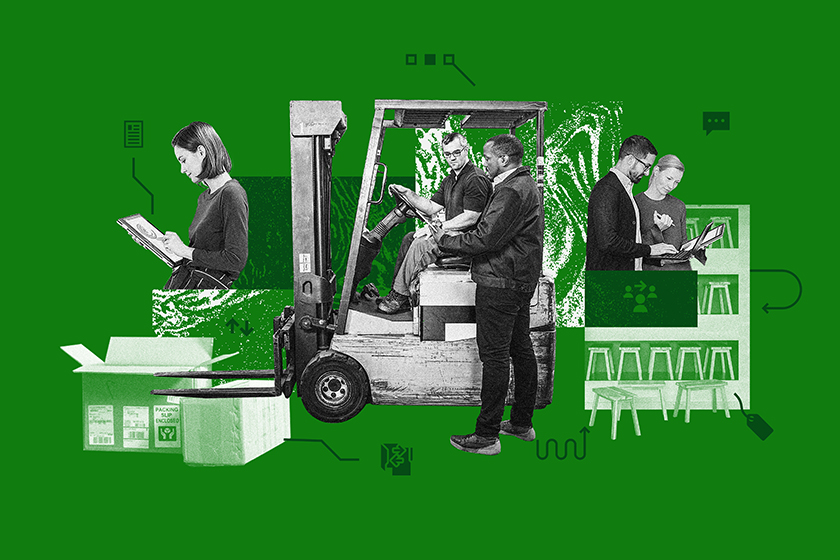
Frontline workers are at an inflection point . Across industries, from hospitality to healthcare to retail, these workers report that they feel their stress levels will only increase in the coming year. Furthermore, as Microsoft detailed in a Work Trend Index (WTI) special report on frontline workers, they often don’t feel like communication from management is reaching them as they handle the needs of customers, navigate COVID-19 protocols, and even deal with supply chain issues.
Frontline workers are also at a different sort of inflection point, a more positive one, which is that the technological tools that have long made the jobs of desk workers more seamless are now reaching them. That’s one of the big lessons from the National Retail Federation’s “Big Show,” held in New York earlier in January. Microsoft participated in several of the dozens of sessions (although its participation was virtual, due to the Omicron surge) held over the multi-day event.
Retail leaders are always working to figure out better ways to serve customers, but they’re also evolving by figuring out better ways to serve their employees. An emerging realization among global retailers is that by empowering their frontline workforce, they can achieve better business results and a stronger bottom line. “To keep up in the next chapter of retail, we can’t slow down,” the organization notes . “In fact, it’s time to accelerate.”
The following six insights from the event shed light on the future of work across industries—how hybrid work principles are reaching the frontline, the importance of worker empowerment, and the growing digitization of space, including forays into the metaverse. The particulars may be drawn from the world of retail, but the broader trends and principles apply to how, and why, people work now—no matter what their business.
Turn the Great Reshuffle into the great reschedule
Shifting power dynamics in the workforce mean that employees expect more from their bosses than ever before. Indeed, the WTI report found that a desire for more flexibility was one of the top five reasons cited by the workers surveyed for considering a job change. One solution for industries that rely on shift workers, that came up at a session titled “Between a Rock and a Hard Place: Customer Success and Employee Retention in 2022,” is using digital scheduling apps. Tools like Shifts for Microsoft Teams allow employees to self-schedule and swap shifts and request time off, among other things. Digital solutions like these bring the promise of hybrid work to a workforce segment historically left out of digital transformation. Employees who enjoy this type of flexibility may be more likely to stick around—76 percent of workers say they want a permanently flexible schedule .

Create a “supply chain for talent”
The kind of flexibility offered by a shift scheduling app can also give associates the space and inspiration they need to grow. And employees are ready for growth. In a session on education, skilling, and career mobility, speaker John Patterson, vice president of talent at Macy’s, cited a statistic that made him do a double take: 64 million Americans went to college but didn’t obtain a degree.
This gap means there’s a lot of potential to not only help them finish their degrees but provide educational opportunities that could in turn benefit the company as well. But as Rachel Carlson, CEO of Guild Education, an education assistance management company, noted as part of the same session, traditional pathways to helping employees continue their education, like tuition reimbursement programs, often do more harm than good. Carlson told the audience that low-income frontline workers can be ensnared in for-profit colleges with high tuition or unaccredited training programs.
Instead, she says, to embrace and enhance their labor pools, corporations should create internal education programs that offer pathways for frontline workers to move to the corporate side without ever having to leave the company. And technology can help. Microsoft Viva , for example, is deeply integrated with LinkedIn Learning and other upskilling resources to help people learn and grow in the flow of work.
One retail worker was a self-trained cybersecurity buff. She took a course within the company and was ultimately transferred to the corporate office.
But it’s also critical for organizations to provide resources like a so-called upskilling roadmap that lays out the options available to employees on a digital dashboard—where they can register for courses (both internally and at partner universities, depending on their circumstances) and learn more about available opportunities. At Chipotle, for example, employees who engaged in these programs were 750 percent more likely to get promoted. At Walmart, Carlson says, one retail worker was a self-trained cybersecurity buff. She took a course within the company, her skills were recognized, and she was transferred to the corporate office. Patterson hopes to see similar success stories within the Macy’s program, which launches next month. It’s a sound strategy for companies that want to ease the challenge of hiring and retention. As Patterson puts it: “At Macy’s, we need to think more like a supply chain for talent.”
Harden supply chain resiliency by enhancing data visibility
The supply chain for actual goods and materials, of course, has been under immense pressure the past two years, and in the WTI frontline worker report, half of the frontline workers surveyed reported frustration with supply chain issues. And frustrated workers can lead to frustrated customers. As he detailed in his session “Logjam at the Ports: What Happens Next?” Ryan Petersen, CEO of freight forwarding and customs brokerage company Flexport, decided last October to observe the supply chain crisis up close. He rented a boat and cruised around San Pedro Bay, off the coast of California. He saw dozens of ships waiting to dock. He spoke with port employees; they said that truck drivers were missing 50 percent of their pickup appointments, leaving containers stranded. And the truck drivers said the entire system, including the regulations that govern it, was broken. Petersen launched a tweetstorm about what he discovered, and within a few hours, Long Beach changed the regulations , allowing containers to be stacked and opening up more space on the docks for new deliveries.
The broader fix? It’s an extremely complex issue of course, but new technology, like Dynamics 365 Supply Chain Insights , can help create more intelligent and adaptable supply chains through digitization, enhancing visibility, improving planning, and maximizing asset productivity. The result is that organizations can predict disruptions and respond quickly—ultimately helping frontline workers do their jobs better.
The ability to adapt is key to survival
Retailers responded to the beginning of the pandemic by offering curbside pickup. It’s just one of myriad changes they had to make, and in an ever-shifting business and pandemic landscape—whether the issue is staffing shortages or shipment delays—this kind of adaptation is essential. As Alysa Taylor, corporate vice president of industry, apps, and data marketing said in a Microsoft-sponsored session titled “Five Trends Reshaping the World—and How Retailers Are Responding,” “We all learned to fail fast, and pivot even faster.” And to pivot this quickly, companies need to learn to be hyper-connected and data-focused.

Connect with employees so they connect with you
Part of creating a hyper-connected organization is giving employees more transparency from the company they work for: workers want open communication channels, clear and concise directives, and a sense of ownership over their employer’s mission. Indeed, the WTI report found that more than half of frontline workers don’t feel like communication is reaching them effectively . And a third feel like their concerns are not being heard when they try to communicate workplace issues.
As part of the same “Five Trends” session, Taylor gave the example of how jewelry retailer Kendra Scott mitigated these issues. With more than 200 locations, the company was seeing a communication breakdown within its business: the corporate team had no way to communicate directly with their frontline associates or assign tasks consistently across stores. This led to missed deadlines and an inconsistent customer experience, Taylor said. So Kendra Scott turned to Microsoft Teams and the Task app to hyper-connect its business. “The communications team can assign duties,” Taylor says, “and they can see when those tasks are completed, giving the corporate team better data on whether a campaign was effective, whether a store needs additional stylists, or whether managers need support.”
Workers want open communication channels and a sense of ownership over their employer’s mission.
The infinite virtual marketplace
A seamless in-store experience can empower workers as much as it delights customers. A seamless virtual experience can do the same—and from anywhere. In a session titled “The New World: The Challenges and Promises of the Metaverse for Retailers,” Emma Chiu, intelligence director at Wunderman Thompson, walked the audience through how fashion houses like Fendi and Burberry are able to expand their in-store experience by offering a digital shop. Live in Iowa and can’t visit a company’s flagship store in Paris? In the metaverse, you can. “People want to go seamlessly between the physical and the virtual,” Chiu says. More daringly, Artifact, a virtual shoe company, recently sold 200 pairs of digital kicks in seven minutes and pocketed over $3 million before being acquired by Nike. And as the physical and digital worlds converge, these consumer experiences are just a single example of the vast transformation that the metaverse will have on work and life.
As Microsoft CEO Satya Nadella noted in his 2021 Ignite keynote address , “For years, we’ve talked about creating this digital representation of the world, but now, we actually have the opportunity to go into that world and participate in it.” And when we do, the experiences of customers and workers alike—enhanced and empowered by technology—will remain crucial. “What’s most important is that we are able to bring our humanity with us, and choose how we want to experience this world and who we want to interact with.”

